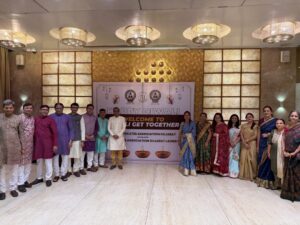GST WEEKLY UPDATE :3/2022-23 (17.04.2022) by CA Vipul Khandhar

By CA Vipul Khandhar,
- 2- Factor Authentication for e-Way Bill and e- Invoice System:
To enhance the security of e-Way Bill/e-Invoice System, NIC is introducing 2- Factor Authentication for logging in to e-Way Bill/e-Invoice system. In addition to username and password, OTP will also be authenticated for login.
There are 3 different ways of receiving the OTP. You may enter any of the OTP and login to system. The various modes of generating OTP are explained below:
- SMS: OTP will be sent to your registered mobile number as SMS.
- On ‘Sandes’ app: Sandes is a messaging app provided by government so that you can send and receive messages. You may download and install the Sandes app on your registered mobile number and receive the OTP in it.
- Using ‘NIC-GST-Shield’ app: ‘NIC-GST-Shield’ is a mobile app provided by e- Way Bill /e-Invoice System, so that OTP can be generated by using the app. This app can be downloaded only from the e-Waybill / e-Invoice portal from the link ‘Main Menu 2-Factor Authentication Install NIC-GST-Shield’. Download, install and register this app on your registered mobile number. You should ensure the time displayed in the app should be in sync with e- Waybill / e-Invoice system. On opening the app, OTP is displayed. You may enter this OTP and continue the authentication. The OTP gets refreshed after every 30 seconds. You will not require internet or any dependency on mobile network for generating the OTP on this app.
Registration for 2-Factor Authentication:
On logging to e-Waybill System go to Main Menu 2 Factor Authentication and confirm the registration. Once confirmed, the system will ask OTP along- with username and password. The OTP authentication is based on individual user accounts. The sub users of GSTIN will have separate authentication depending on their registered mobile number in the e-Way Bill/ e- Invoice System. Once you have registered for 2 Factor authentication, then the same is applicable for both e-Way bill and e-Invoice system.
You may de-register this facility anytime using the link ‘2 Factor Authentication Registration / Deregistration’. This facility is presently being introduced on optional basis; however, in future it will be made mandatory.
- CBIC enabled the Shipping Bill amendment facility on ICEGATE:
The Central Board of Indirect Taxes and Customs (“CBIC”) has enabled the Shipping Bill amendment facility on ICEGATE.
Users can file Shipping Bill amendments using CACHE01_A message.
- EPCG export obligation relaxation & increase in time limit with the additional fees. DGFT vide Public Notice No. 03/2015-2020 dated April 13, 2022:
| S. No. | Para No. | Revised provision |
| 1 | 5.14 (c) | 5.14 Block-wise Fulfilment of EO
(c) Request for extension of Export Obligation period of first block shall be submitted within 6 months from the date of expiry of first block EO period along with composition fee of 2% on duty saved amount proportionate to unfulfilled portion of EO pertaining to the block. RA may consider the request for extension of block wise EO period, received after 6 months, but within 6 years from date of issue of authorization, with a late fee of Rs. 10,000/- per authorization. Application made beyond 6 years, for extension of block-wise EO period for regularization purpose, shall also be considered by RA concerned, with an additional late fee of Rs. 5,000/- for each year per authorization. This late fee is in addition to the composition fee that may be payable on account of shortfall in export obligation. Where EO of the first block is not fulfilled in terms of para (a) above, except in cases where the EO prescribed for first block is extended by the Regional Authority, the Authorization holder shall, within 6 months from the expiry of the block, pay duties of customs (along with applicable interest as notified by DOR) proportionate to duty saved amount on total unfulfilled EO of the first block. |
| 2 | 5.15 | 5.15 Annual reporting of EO fulfillment
Authorisation holders shall submit to the RA concerned by 30th June of every year, a report on fulfillment of export obligation through online. Such a report shall contain details such as Shipping bill/GST invoice number, date of export/supply, description of product exported/supplied and FOB/FOR value of export/supply for both specific as well as average export obligation. Any delay in filing such an annual report shall be regularised on payment of Rs. 5000/- late fees for each financial year per authorisation. |
| 3 | 5.16 (a) | 5.16 Automatic Reduction/ Enhancement upto 10% Duty saved amount and pro rata Reduction/ Enhancement in export obligation
(a) in excess of the duty saved amount indicated on the authorization by not more than 10%, the authorization shall be deemed to have been enhanced by that proportion. Customs shall automatically allow clearance of such goods without endorsement by RA concerned. The authorization holder shall furnish additional fee to cover excess imports affected, in terms of duty saved amount, to RA concerned, at the time of application for EODC. Export obligation shall automatically stand enhanced proportionately. |
| 4 | 5.17(d) | 5.17 Extension in Export Obligation Period.
(d) Request for extension in EO Period shall be made to RA concerned within 6 months from the date of expiry of original EO Period. However, RA may consider the request for extension received after 6 months, but within 8 years from date of issue of authorization, with a late fee of Rs. 10,000/-. Application made beyond 8 years, for extension of EO period from 6 to 8 years for regularization purpose, shall also be considered by RA concerned, with an additional late fee of Rs. 5,000/- for each year per authorization. This fee is in addition to the composition fee that may be payable on account of shortfall in export obligation. However, EO extension, beyond 8 years from date of issue of authorisation, shall not be allowed by RA under this provision. |
| 5 | 5.19 A | 5.19A – Maintenance of Annual Average Export Obligation
The excess exports done towards the average export obligation fulfillment of an EPCG authorization during a year can be used to offset any shortfall in the Average EO done in other year(s) of the EO period or the block period as the case may be, provided Average EO imposed is maintained on an overall basis, within the EO period. |
| 6 | 5.22 (a) & (b) | 5.22 Export Obligation Discharge Certificate (EODC)
(a) Authorisation holder shall apply for EODC in ANF 5B with documents prescribed therein as a proof of EO fulfillment. (b) On being satisfied, RA concerned shall issue EODC to the EPCG authorisation holder and a copy of which will be forwarded to ICEGATE through online, for further action by Jurisdictional Customs Authorities with whom BG/LUT has been executed. Where EODC is granted to the EPCG authorisation holder based on online application, a copy of EODC will be forwarded online to ICEGATE for further action by Jurisdictional Customs Authorities with whom BG/LUT has been executed. |
| 7 | 5.23 (a) | 5.23 Regularization of Bonafide Default and Exit from EPCG Scheme
(a) In case, EPCG authorisation holder fails to fulfill prescribed export obligation, he shall pay Customs Duty/taxes/Cess along with applicable interest as prescribed by Customs Authority. Such facility can also be availed by EPCG authorisation holder to exit at his option. |
Effect of this Public Notice: With a view to enhance ease of doing business and reduce the compliance burden, certain provisions of Chapter 5 related to the Export Promotion Capital Goods Scheme of the Handbook of Procedures (2015-20) are amended for EPCG authorizations issued under Foreign Trade Policy (2015-20).
- Recent AAR & Judicial Decisions:-
(i) AAR On benefit of additional input tax credit had not been passed on to the home buyers or not:
(In the case of DG, Anti-Profiteering CBIC Vs. Alton Buildtech India P Ltd)
The service rendered by the Respondent by way of construction and development of the project was not in existence during the pre-GST regime.
As project was launched after implementation of the GST w.e.f. 01.07.2017, apparently there was no pre-GST tax rate or input tax credit availability that could be compared with the post-GST tax rate and the input tax credit, to determine whether there was any benefit that was required to be passed on by way of reduced prices. The Respondent has not contravened the provisions of Section 171 (1) of the CGST Act, 2017 and there is no merit in the instant case and the same is accordingly dismissed.
(ii) AAR On GST is applicable on a total of the escalated value plus the original value of the contract
(Applicant – M/s. B. P. Sangle Construction Pvt. Ltd)
The Maharashtra Authority of Advance Ruling has held that GST is applicable on a total of the escalated value plus the original value of the contract. The applicant M/s. B. P. Sangle Construction Pvt. Ltd., is engaged in the construction of public roads for the Government authorities and also provides construction services for Private parties. The applicant has been awarded a tender from NHAI for the construction of roads for a certain amount. There is a clause in the tender according to which, in case there is a change in the rates of labor, steel, cement, plant, machinery, spares, bitumen, lubricants, etc. the contract price shall increase or decrease as per the formula provided in the tender notice. In the event of such escalation of value, the same shall be recovered in addition to tender value from NHAI. Applicant approached advance ruling authority to clarify whether the escalated value shall be added to taxable value under section 15 of the GST Act. The applicant submitted that before the GST regime NHAI invited proposals for the work development, maintenance, and management of the National Highway. The activity to construct roads for the public was exempted from payment of service tax under Sr. No. 13(a) of Notification No: 25/2012-ST under the Erstwhile Service Tax laws. When the contract was awarded only Maharashtra VAT was applicable and hence taken into consideration and the said contract price was including of VAT at the rate of 5% only. The advance ruling authority has observed that there was no supply during the pre-GST period and no invoice was also raised during the said period. The service was provided entirely during the GST period and therefore in view of section 13, the time of supply is during the GST era, and for ascertaining the value of service the relevant provisions of CGST Act 2017 shall apply. It was further observed by the authority that section 15(1) says that the value of supply of goods or services or both shall be the transaction value and the transaction value in the subject case will also include the escalating value, which is being recovered from NHAI by the applicant. Therefore such escalated value or price which is added to contract price shall be liable for payment of GST as per the provisions of section 15 of the Act.
Disclaimer:
This publication contains information for general guidance only. It is not intended to address the circumstances of any particular individual or entity. Although the best of endeavour has been made to provide the provisions in a simpler and accurate form, there is no substitute to detailed research with regard to the specific situation of a particular individual or entity. We do not accept any responsibility for loss incurred by any person for acting or refraining to act as a result of any matter in this publication.
(The author is a well known Chartered Accountant practicing at Ahmadabad in the field of Direct and Indirect Taxation)





